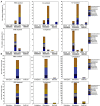Combined Phenanthrene and Copper Pollution Imposed a Selective Pressure on the Rice Root-Associated Microbiome
- PMID: 35602076
- PMCID: PMC9114715
- DOI: 10.3389/fmicb.2022.888086
Combined Phenanthrene and Copper Pollution Imposed a Selective Pressure on the Rice Root-Associated Microbiome
Abstract
Combined organic and inorganic pollutants can greatly impact crops and microbes, but the interaction between coexisted pollutants and their effects on root-associated microbes under flooding conditions remains poorly understood. In this study, greenhouse experiments were conducted to investigate the individual and combined effects of phenanthrene (PHE) and copper (Cu) on rice uptake and root-associated microbial coping strategies. The results showed that more than 90% of phenanthrene was degraded, while the existence of Cu significantly reduced the dissipation of PHE in the rhizosphere, and the coexistence of phenanthrene and copper promoted their respective accumulation in plant roots. Copper played a dominant role in the interaction between these two chemicals. Microbes that can tolerate heavy metals and degrade PAHs, e.g., Herbaspirillum, Sphingobacteriales, and Saccharimonadales, were enriched in the contaminated soils. Additionally, microbes associated with redox processes reacted differently under polluted treatments. Fe reducers increased in Cu-treated soils, while sulfate reducers and methanogens were considerably inhibited under polluted treatments. In total, our results uncover the combined effect of heavy metals and polycyclic aromatic hydrocarbons on the assemblage of root-associated microbial communities in anaerobic environments and provide useful information for the selection of effective root-associated microbiomes to improve the resistance of common crops in contaminated sites.
Keywords: combined pollution; flooding condition; heavy metal; polycyclic aromatic hydrocarbon; root-associated microbiome.
Copyright © 2022 Li, Xu, Su, Zhang, Niu and Xu.
Conflict of interest statement
MX was employed by Shandong Academy of Environmental Sciences Co., Ltd. The remaining authors declare that the research was conducted in the absence of any commercial or financial relationships that could be construed as a potential conflict of interest.
Figures







Similar articles
-
Assembly strategies of the wheat root-associated microbiome in soils contaminated with phenanthrene and copper.J Hazard Mater. 2021 Jun 15;412:125340. doi: 10.1016/j.jhazmat.2021.125340. Epub 2021 Feb 5. J Hazard Mater. 2021. PMID: 33951882
-
Resilience of the wheat root-associated microbiome to the disturbance of phenanthrene.Sci Total Environ. 2022 Sep 10;838(Pt 3):156487. doi: 10.1016/j.scitotenv.2022.156487. Epub 2022 Jun 3. Sci Total Environ. 2022. PMID: 35667431
-
Dissipation of phenanthrene and pyrene at the aerobic-anaerobic soil interface: differentiation induced by the rhizosphere of PAH-tolerant and PAH-sensitive rice (Oryza sativa L.) cultivars.Environ Sci Pollut Res Int. 2015 Mar;22(5):3908-19. doi: 10.1007/s11356-014-3657-2. Epub 2014 Oct 8. Environ Sci Pollut Res Int. 2015. PMID: 25292301
-
Soil Characteristics Constrain the Response of Microbial Communities and Associated Hydrocarbon Degradation Genes during Phytoremediation.Appl Environ Microbiol. 2021 Jan 4;87(2):e02170-20. doi: 10.1128/AEM.02170-20. Print 2021 Jan 4. Appl Environ Microbiol. 2021. PMID: 33097512 Free PMC article.
-
Genetically engineered microbial remediation of soils co-contaminated by heavy metals and polycyclic aromatic hydrocarbons: Advances and ecological risk assessment.J Environ Manage. 2021 Oct 15;296:113185. doi: 10.1016/j.jenvman.2021.113185. Epub 2021 Jul 6. J Environ Manage. 2021. PMID: 34243092 Review.
Cited by
-
Exploring and exploiting the rice phytobiome to tackle climate change challenges.Plant Commun. 2024 Dec 9;5(12):101078. doi: 10.1016/j.xplc.2024.101078. Epub 2024 Sep 3. Plant Commun. 2024. PMID: 39233440 Free PMC article. Review.
-
Assessing Microbial Activity and Rhizoremediation in Hydrocarbon and Heavy Metal-Impacted Soil.Microorganisms. 2025 Apr 8;13(4):848. doi: 10.3390/microorganisms13040848. Microorganisms. 2025. PMID: 40284684 Free PMC article.
-
Combined contribution of biochar and introduced AM fungi on lead stability and microbial community in polluted agricultural soil.Front Microbiol. 2023 Nov 15;14:1284321. doi: 10.3389/fmicb.2023.1284321. eCollection 2023. Front Microbiol. 2023. PMID: 38033595 Free PMC article.
-
Effects of simulated acid rain on hydrochemical factors and microbial community structure in red soil aquifers.RSC Adv. 2024 Feb 2;14(7):4482-4491. doi: 10.1039/d3ra08820k. eCollection 2024 Jan 31. RSC Adv. 2024. PMID: 38312729 Free PMC article.
References
-
- Babu T. S., Marder J. B., Tripuranthakam S., Dixon D. G., Greenberg B. M. (2001). Synergistic effects of a photooxidized polycyclic aromatic hydrocarbon and copper on photosynthesis and plant growth: evidence that in vivo formation of reactive oxygen species is a mechanism of copper toxicity. Environ. Toxicol. Chem. 20, 1351–1358. doi: 10.1002/etc.5620200626, PMID: - DOI - PubMed
-
- Cao L., Shen G., Lu Y. (2007). Combined effects of heavy metal and polycyclic aromatic hydrocarbon on soil microorganism communities. Environ. Geol. 54, 1531–1536. doi: 10.1007/s00254-007-0934-0 - DOI
LinkOut - more resources
Full Text Sources

